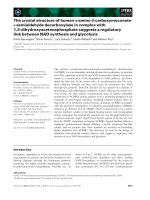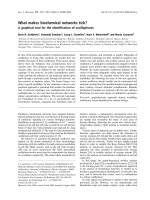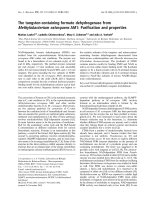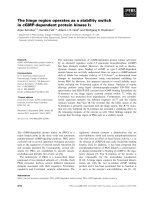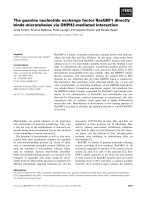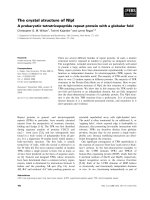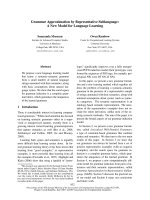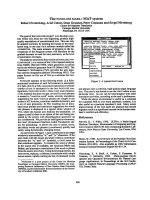Báo cáo khoa học: The competitor-introduced Gc recruitment system, a new approach for screening affinity-enhanced proteins doc
Bạn đang xem bản rút gọn của tài liệu. Xem và tải ngay bản đầy đủ của tài liệu tại đây (305.39 KB, 9 trang )
The competitor-introduced Gc recruitment system,
a new approach for screening affinity-enhanced proteins
Nobuo Fukuda
1
, Jun Ishii
2
, Tsutomu Tanaka
2
and Akihiko Kondo
1
1 Department of Chemical Science and Engineering, Graduate School of Engineering, Kobe University, Japan
2 Organization of Advanced Science and Technology, Kobe University, Japan
Introduction
Directed evolution is an extremely useful approach in
protein engineering that is used to produce novel pro-
teins with desirable properties that are not found in
nature [1–3]. This approach has been successfully
applied to engineer a wide range of protein functions,
such as activity, stability, selectivity, specificity and
affinity [4]. ‘Bio-panning’ is broadly used for the engi-
neering of protein affinity, mostly based on phage
Keywords
affinity enhancement; competitor-introduced
system; directed evolution; G-protein
signaling; yeast two-hybrid
Correspondence
A. Kondo, Department of Chemical Science
and Engineering, Graduate School of
Engineering, Kobe University, 1-1
Rokkodaicho, Nada-ku, Kobe 657-8501,
Japan
Fax: +81 78 803 6196
Tel: +81 78 803 6196
E-mail:
(Received 8 December 2009, revised
18 January 2010, accepted 26 January
2010)
doi:10.1111/j.1742-4658.2010.07592.x
We have developed a new approach based on the Gc recruitment system to
screen affinity-enhanced proteins by expressing a binding competitor. The
previously established Gc recruitment system is a yeast two-hybrid (Y2H)
system that utilizes G-protein signaling, and is based on the fact that mem-
brane localization of the G-protein c subunit (Gc) is essential for signal
transduction in yeast. In the original Y2H system, an engineered Gc that
lacks membrane localization upon deletion of the lipid modification site
(Gc
cyto
) is produced, and a candidate protein with an artificial lipidation
site and its counterpart fused with Gc
cyto
are expressed. As protein–protein
interactions bring Gc
cyto
towards the plasma membrane, G-protein signal-
ing can be activated, and the interaction is detected by various cellular
responses as the readout. In the current study, we expressed a third cyto-
solic protein that competes with the candidate protein to specifically isolate
affinity-enhanced mutants from a mutation library of the candidate pro-
tein. Enhancing the affinity of the protein candidate guides the counter-
part–Gc
cyto
fusion protein towards the plasma membrane and activates
signaling. Using mutants of the Z domain derived from Staphylococ-
cus aureus protein A as candidate proteins or competitors, and the Fc por-
tion of human immunoglobulin G (IgG) as the counterpart, we
demonstrate that affinity-enhanced proteins can be effectively screened
from a library containing a 10 000-fold excess of non-enhanced proteins.
This new approach, called the competitor-introduced Gc recruitment sys-
tem, will be useful for efficient discovery of rare valuable candidates hidden
among excess ordinary ones.
Structured digital abstract
l
MINT-7556266: Fc portion of human IgG (uniprotkb: P01857) physically interacts (MI:0915)
with Z domain of protein A (uniprotkb:
P38507)bytwo hybrid (MI:0018)
Abbreviations
EGFP, enhanced green fluorescent protein; Gc, G-protein c subunit; Y2H, yeast two-hybrid; Z
K35A,
single-site mutant of the Z domain by
altering lysine 35 to alanine; Z
WT,
wild-type Z domain derived from the B domain of Staphylococcus aureus protein A; ZZ, dimer of wild-type
Z domain.
1704 FEBS Journal 277 (2010) 1704–1712 ª 2010 The Authors Journal compilation ª 2010 FEBS
display techniques [5]. This approach makes it possible
to isolate affinity-enhanced variants from a library
under highly specific elution conditions; however, it is
difficult to design suitable elution conditions, and the
procedure may require multiple cycles of isolation and
amplification to exclude non-enhanced variants.
Recently, the use of yeast two-hybrid (Y2H) sys-
tems for affinity enhancement has been reported [3,6].
These systems successfully enhance the affinity of tar-
get proteins towards their binding partners by regulat-
ing the concentration of the partners. A low
concentration leads to a reduction in sensitivity such
that the interaction cannot be detected; therefore, only
affinity-enhanced variants can be isolated in these sys-
tems. Unfortunately, these applications are limited to
particular interactions such as receptor–ligand inter-
actions or interactions in nature that are originally
weak.
Here we propose a new approach based on a Y2H
system to enhance protein affinity by expressing a
binding competitor. The competitor-introduced Y2H
system can specifically isolate affinity-enhanced vari-
ants from a genetically mutated library by expressing
the original or an improved protein as a competitor.
The advantage of this approach is that it can be easily
used for screening binding partners with quite strong
affinities and various candidates just by altering the
competitor, and requires just a single cycle of isolation.
In this study, we utilized the Gc recruitment system,
a Y2H system that utilizes yeast G-protein signaling
[7], to demonstrate the applicability of the competitor-
introduced approach for affinity enhancement. The
Z domain derived from staphylococcal protein A was
selected as a model protein for affinity enhancement,
and the Fc portion of human IgG was selected as its
counterpart [8,9].
Results
Competitor-introduced Gc recruitment system
The Gc recruitment system is a Y2H system that was
previously designed to detect protein–protein interac-
tions based on the finding that signal transduction
requires localization of the Gbc complex to the plasma
membrane through a lipidated Gc subunit in yeast [10].
Formation of Gc mutants by deletion of their lipidation
sites completely interrupts G-protein signaling [10], and
protein–protein interactions lead to activation of G-pro-
tein signaling by recruiting the Gc mutants towards the
plasma membrane [7]. The outputs appear as various
cellular responses, including global changes in transcrip-
tion in preparation for mating.
An outline of our strategy for affinity enhancement,
designated the competitor-introduced Gc recruitment
system, is shown in Fig. 1. The expression of binding
competitor ‘C’ in the cytosol (C
cyto
) affects the interac-
tion between target protein ‘A’, which is genetically
fused to a cytosolic Gc mutant (Gc
cyto
), and binding
candidate ‘B’, which is artificially anchored at the
plasma membrane (B
mem
). When the affinity between
‘A’ and ‘B’ is lower than that between ‘A’ and ‘C’, the
‘A’–Gc
cyto
fusion protein preferentially binds to C
cyto
and cannot localize to the plasma membrane, and there-
fore the G-protein signal is not activated (Fig. 1A). In
contrast, when ‘B’ binds to ‘A’ more strongly than to
‘C’, the ‘A’–Gc
cyto
fusion protein migrates towards the
B
mem
protein at the plasma membrane, the G-protein
signal is activated, and the cellular response in the yeast
mating process is induced (Fig. 1B).
To verify the efficacy of the strategy described in
Fig. 1, we examined whether affinity-enhanced variants
specifically induce signal transduction in haploid cells
α
α
γ
γ
β
β
GTP
AB
GTP
BBA
C
Effector Effector
Signal
EGFP gene transcription
Mating
No signal
CA
Fig. 1. Outline of the experimental design. Engineered Gc lacking membrane localization ability (Gc
cyto
) is genetically prepared, and binding
target ‘A’ is fused to Gc
cyto
. Binding candidate ‘B’ is located on the plasma membrane and the competitor ‘C’ is introduced into the cytosol.
(A) When ‘A’ prefers to bind to ‘C’, G-protein signaling is prevented by sequestration of Gc
cyto
from the plasma membrane. (B) When ‘A’
prefers to bind to ‘B’, G-protein signaling is transmitted to induce EGFP gene transcription and the yeast mating process.
N. Fukuda et al. A new approach to screen affinity-enhanced proteins
FEBS Journal 277 (2010) 1704–1712 ª 2010 The Authors Journal compilation ª 2010 FEBS 1705
in the presence of the competitors, and whether the
resulting signal can be used to screen affinity-enhanced
variants using diploid cell formation.
Verification of the growth selection method
using the mating machinery to screen protein–
protein interactions in the Gc recruitment system
Yeast haploid strains BY4741, consisting of a specific
methionine prototrophic a cell, and BY4742, consisting
of a specific lysine prototrophic a cell [11], were uti-
lized as parental strains for construction of our system.
The genetic modifications shown in Table 1 were per-
formed for BY4741 only, and the recovery of phero-
mone signaling in the engineered a cell was used to
detect protein–protein interactions. Briefly, the interac-
tion between ‘A’–Gc
cyto
and ‘B
mem
’ restores signaling
and induces transcription of the EGFP reporter gene
in the Gc recruitment system as described previously
[7], in addition to simultaneously activating the cellular
responses required for the mating process. To test the
screening procedure, we examined whether the yeast
mating machinery can be used to screen signaling-
recovered cells by protein–protein interactions as in
our previous system. The engineered a cell that
restores pheromone signaling by protein–protein
interactions mates with an intact a cell, and the diploid
cell generated survives on medium lacking methionine
and lysine.
Interactions of BFG2Z18-K35A, BFG2Z18-WT and
BZFG2118 (Tables 1 and 2), which express the Fc por-
tion of human IgG as protein ‘A’, with several Z
variants with various affinities for the Fc portion
(Z
K35A
, 4.6 · 10
6
M
)1
;Z
WT
, 5.9 · 10
7
M
)1
; ZZ, 6.8 ·
10
8
M
)1
) [12] as protein ‘B’, transduce pheromone sig-
naling [7]. However, BFG2118 (Tables 1 and 2), which
is a negative control and expresses the Fc protein fused
to the Gc
cyto
protein, cannot trigger signal transduction
[7]. To verify the feasibility of growth selection via the
yeast mating machinery, these four strains were co-cul-
tivated with intact mating partner BY4742 (Table 1)
and then spotted onto diploid selectable methionine-
and lysine-lacking medium. As a result, BFG2118 did
not survive but the other three strains were able to
grow (Fig. 2A). To quantitatively estimate the survival
of these strains, 1 mL of cell suspension from each
strain (attenuance at 600 nm adjusted to 1.0;
D
600
= 1.0) was spread on the same selection medium,
and the colony numbers were counted. There were
obvious differences in colony numbers, corresponding
to the affinity constants shown in Fig. 2B. These results
suggest that the mating abilities of the a cells were
retrieved and diploid cells were produced in agreement
with signaling in response to protein–protein interac-
tions, and that the growth selection method using yeast
mating is adequate to screen candidates for protein–
protein interactions in the Gc recruitment system.
Table 1. List of yeast strains used in this study.
Strain Genotype Reference sources
BY4741 MATa his3D1 ura3D0 leu2D0 met15D0 Brachmann et al. (1998)
MC-F1 BY4741 P
FIG 1
-FIG 1-EGFP Ishii et al. (in preparation)
a
BFG2118 MC-F1 ste18D::kanMX4 his3D::URA3-P
STE18
-Gc
cyto
-Fc Fukuda et al. (2009)
BFG2Z18-K35A MC-F1 ste18D::kanMX4-P
PGK1
-Z
K35A, mem
his3D::URA3-P
STE18
-Gc
cyto
-Fc Fukuda et al. (2009)
BFG2Z18-WT MC-F1 ste18D::kanMX4-P
PGK1
-Z
WT, mem
his3D::URA3-P
STE18
-Gc
cyto
-Fc Fukuda et al. (2009)
BZFG2118 MC-F1 ste18D::kanMX4-P
PGK1
-ZZ
mem
his3D::URA3-P
STE18
-Gc
cyto
-Fc Fukuda et al. (2009)
FC1-1 BFG2Z18-K35A P
HOP2
::LEU2-P
PGK1
-Z
K35A
Present study
FC2-1 BFG2Z18-WT P
HOP2
::LEU2-P
PGK1
-Z
K35A
Present study
FC3-1 BZFG2118 P
HOP2
::LEU2-P
PGK1
-Z
K35A
Present study
FC1-2 BFG2Z18-K35A P
HOP2
::LEU2-P
PGK1
-Z
WT
Present study
FC2-2 BFG2Z18-WT P
HOP2
::LEU2-P
PGK1
-Z
WT
Present study
FC3-2 BZFG2118 P
HOP2
::LEU2-P
PGK1
-Z
WT
Present study
BY4742 MATa his3D1 ura3D0 leu2D0 lys2D0 Brachmann et al. (1998)
a
J. Ishii, M. Moriguchi, S. Matsumura, K. Tatematsu, S. Kuroda, T. Tanaka, T. Fujiwara, H. Fukuda & A. Kondo, unpublished results.
Table 2. List of proteins expressed in the engineered yeast strains.
Strain
Membrane
target protein (A)
Gc
cyto
fusion
protein (B)
Competitor
protein (C)
BFG2118 – Gc
cyto
-Fc –
BFG2Z18-K35A Z
K35A,mem
Gc
cyto
-Fc –
BFG2Z18-WT Z
WT,mem
Gc
cyto
-Fc –
BZFG2118 ZZ
mem
Gc
cyto
-Fc –
FC1-1 Z
K35A,mem
Gc
cyto
-Fc Z
K35A
FC2-1 Z
WT,mem
Gc
cyto
-Fc Z
K35A
FC3-1 ZZ
mem
Gc
cyto
-Fc Z
K35A
FC1-2 Z
K35A,mem
Gc
cyto
-Fc Z
WT
FC2-2 Z
WT,mem
Gc
cyto
-Fc Z
WT
FC3-2 ZZ
mem
Gc
cyto
-Fc Z
WT
A new approach to screen affinity-enhanced proteins N. Fukuda et al.
1706 FEBS Journal 277 (2010) 1704–1712 ª 2010 The Authors Journal compilation ª 2010 FEBS
Expression of an interacting competitor inhibits
the restoration of signaling in the Gc recruitment
system and excludes the detection of
non-enhanced variants
To examine whether the expression of competitors
prevents the recovery of G-protein signal transduction
as shown in Fig. 1, two competitors, soluble Z
K35A
and
Z
WT
, were introduced singly into three a-type strains,
BFG2Z18-K35A, BFG2Z18-WT and BZFG2118
(Tables 1 and 2), and signal transduction was quantita-
tively evaluated based on transcriptional activity of the
EGFP reporter gene. Fig. 3A shows the results for yeast
strains with Z
K35A
as the competitor. FC1-1 (Gc
cyto
–
Fc ⁄ Z
K35A,mem
⁄ Z
K35A
) exhibited no fluorescence and a
significant decrease in fluorescence intensity occurred in
FC2-1 (Gc
cyto
–Fc ⁄ Z
WT,mem
⁄ Z
K35A
) upon expression of
the competitors, but no decay of fluorescence was
observed in FC3-1 (G c
cyto
–Fc ⁄ ZZ
mem
⁄ Z
K35A
). In the
case of yeast strains possessing Z
WT
as the competi-
tor (Fig. 3B), FC1-2 (Gc
cyto
–Fc ⁄ Z
K35A,mem
⁄ Z
WT
) and
FC2-2 (Gc
cyto
–Fc ⁄ Z
WT,mem
⁄ Z
WT
) did not exhibit
fluorescence, and a slight decrease in fluorescence inten-
sity occurred in FC3-2 (Gc
cyto
–Fc ⁄ ZZ
mem
⁄ Z
WT
). These
results suggest that expression of competitors in the
cytosol strongly affected signal transduction by inhibit-
ing the interactions between Gc
cyto
-fused Fc and several
partners attached to the plasma membrane, and com-
pletely interrupted the migration of Gc
cyto
towards
the plasma membrane when the affinity constant of the
competitor was equal to or greater than that of the
membrane-associated binding partner.
Strain
100 000
BFG
BFG2Z18 BFG2Z18 BZFG
2118 –K35A –WT 2118
D
600
1000
10 000
1
10
100
Cell count
0.1
0.01
1
AB
Fig. 2. Restoration of mating ability by protein–protein interactions without competitors. (A) Growth assay to test the mating ability of yeast
strains. (B) Quantitative evaluation of mating ability indicated by the number of diploid cells formed by 1 mL of cell suspension with D
600
set
at 1.0. BY4742 was used as the mating partner. Standard errors of three independent experiments are shown.
250
250
150
200
150
200
50
100
50
100
0
Fluorescence intensity
0
Fluorescence intensity
Z
K35A
Z
WT
ZZ
Z
K35A
Z
WT
ZZ
On plasma membraneOn plasma membrane
AB
Fig. 3. Flow cytometric EGFP fluorescence analyses for comparing the G-protein signal level. (A) Fluorescence intensity measured in the
competitor Z
K35A
-introduced strains (yeast strain generated by introducing Z
K35A
as the competitor) (FC1-1, FC2-1 and FC3-1). (B) Fluores-
cence intensity measured in the competitor Z
WT
-introduced strains (yeast strain generated by introducing Z
WT
as the competitor) (FC1-2,
FC2-2 and FC3-2). Dark gray bars indicate yeast strains without competitors (BFG2Z18-K35A, BFG2Z18-WT and BZFG2118), and light gray
bars indicate competitor-introduced strains. To investigate transduction of the signal, 5 l
M of a factor was used for each strain. Standard
errors of three independent experiments are shown.
N. Fukuda et al. A new approach to screen affinity-enhanced proteins
FEBS Journal 277 (2010) 1704–1712 ª 2010 The Authors Journal compilation ª 2010 FEBS 1707
Use of the competitor-introduced Gc recruitment
system to screen affinity-enhanced variants
To verify the ability of the competitor expression to
screen affinity-enhanced variants, the mating abilities
of yeast strains possessing competitors were evaluated
(Fig. 4). In agreement with the EGFP reporter assay,
FC1-1 did not generated diploid cells, while FC2-1
and FC3-1 grew on the diploid selectable medium
(Fig. 4A). The mating abilities of FC2-1 and FC3-1
were almost equivalent to those of yeast strains with-
out Z
K35A
as the competitor (Fig. 4C). Similar results
were obtained in the case of yeast strains possessing
Z
WT
as the competitor. FC1-2 and FC2-2 did not
exhibited mating ability; only FC3-2 generated diploid
cells and exhibited an almost equivalent mating ability
to yeast strains without the competitor (Fig. 4B,D).
These results suggest that introduction of an appropri-
ate competitor is adequate for screening superior vari-
ants of binding partners compared to original
partners.
Finally, to clarify the capabilities of the competitor-
introduced Gc recruitment system for affinity enhance-
ment, screening efficiencies were evaluated using model
libraries as follows. The Z domain and ZZ domain
were selected as model proteins of an original binding
partner and affinity-enhanced binding partner, respec-
tively, and two artificial libraries were prepared. One
contained a minor amount of BZFG2118 as the affin-
ity-enhanced target mutant and an excess amount of
BFG2Z18-WT as the original affinity molecule, while
the other contained a minor amount of FC3-2 as the
affinity-enhanced target mutant and an excess amount
of FC2-2 as the original affinity molecule. Several mix-
ing ratios were used as shown in Table 3. The screen-
ing efficiency was defined as the ratio of target cells
that were obtained on the selection plate divided by
the initial ratio of target cells. These values were
assessed by observing the difference in fragment sizes
between the Z domain (as the original molecule) and
the ZZ domain (as the target mutant) using PCR. As
shown in Table 3, the screening efficiency using the
competitor-introduced system was much greater than
that using a conventional system without a competitor,
and the maximum screening efficiency reached 7000-
fold.
FC1-1 FC2-1 FC3-1
D
600
Strain
AB
CD
FC1-2 FC2-2 FC3-2
D
600
Strain
1
0.1
1
0.1
0.01
0.01
100 000 100 000
100
1000
10 000
100
1000
10 000
1
10
Cell count
1
10
Cell count
Z
K35A
Z
WT
ZZ
On plasma membrane
Z
K35A
Z
WT
ZZ
On plasma membrane
Fig. 4. Evaluation of the mating ability of competitor-introduced strains. (A) Growth assay to test the mating ability of yeast strains possess-
ing competitor Z
K35A
. (B) Growth assay to test the mating ability of yeast strains possessing competitor Z
WT
. (C) Quantitative evaluation of
the mating ability of yeast strains possessing competitor Z
K35A
. (D) Quantitative evaluation of the mating abilities of yeast strains possessing
competitor Z
WT
. Dark gray bars indicate yeast strains without competitors (BFG2Z18-K35A, BFG2Z18-WT and BZFG2118), and light gray bars
indicate competitor-introduced strains. Mating ability was quantitatively evaluated by the number of diploid cells formed by 1 mL of cell sus-
pension, with D
600
set at 1.0. BY4742 was used as the mating partner. Standard errors of three independent experiments are shown.
A new approach to screen affinity-enhanced proteins N. Fukuda et al.
1708 FEBS Journal 277 (2010) 1704–1712 ª 2010 The Authors Journal compilation ª 2010 FEBS
Discussion
The aim of this study was to establish a novel approach
for affinity enhancement that can be applied to a diverse
range of proteins on the basis of the Y2H system. The
Z domain derived from Staphylococcus aureus pro-
tein A and the Fc portion of human IgG, which are
widely used as a model interaction pair, were used to
demonstrate the feasibility of our system [13–16]. The
Z domain has a number of variants with a wide range of
affinity constants to the Fc portion, such as Z
K35A
(4.6 · 10
6
M
)1
), Z
WT
(5.9 · 10
7
M
)1
) and ZZ
(6.8 · 10
8
M
)1
) [12], which makes them useful for veri-
fying our new affinity enhancement strategy.
In our system, protein–protein interactions were
converted into G-protein signals through localization
of the yeast Gc subunit to the plasma membrane, and
detected by fluorescence intensity using transcriptional
activation of an EGFP reporter gene in response to
signal transduction [7]. Although use of a fluorescence
reporter allows quantitative assessment of the change
in the signaling level and high-throughput screening
[17], it requires access to a flow cytometer [18]. As a
simpler isolation technique to detect positive clones
without any expensive instruments, we verified the ade-
quacy of growth selection by diploid formation based
on the yeast mating machinery in the current study.
First, we investigated whether the mating machinery
can detect the restoration of pheromone signaling due
to protein–protein interactions using our previous Gc
recruitment system [7]. The results of cell growth on
diploid selectable medium clearly demonstrated the
efficacy of growth selection to screen for protein–pro-
tein interaction pairs with affinity constants ranging
from 4.6 · 10
6
to 6.8 · 10
8
M
)1
(Fig. 2). Although we
successfully detected the interaction between Z
I31K
and
Fc (8.0 · 10
3
M
)1
) by transcriptional assay of an
EGFP reporter gene in a previous study, we did not
prepare and test variants with marginal affinity in the
present study because it focuses on affinity enhance-
ment for protein engineering. The complete elimination
of background growth with a non-interacting pair
(BFG2118) (Fig. 2) clearly shows the usefulness of the
mating machinery for screening with our previous sys-
tem. This extremely low background is due to the fact
that retrieval of signaling is strictly regulated by pro-
tein–protein interactions, and formation of the diploid
absolutely requires the recovered signaling. Although
our previous system is able to discriminate interacting
pairs from non-interacting pairs, it is not sufficient for
screening for affinity-enhanced variants from a pool of
original interacting pairs, suggesting that another
approach is required for efficient screening of affinity
enhancement (Table 3).
As shown in Fig. 1, we hypothesized that expression
of a cytosolic competitor for a membrane-associated
protein could restrict signaling transduction as the
competitor might intercept the Gc-fused protein and
interrupt its migration towards the plasma membrane.
Indeed, introduction of competitors eliminated the
interactions of relatively weaker binders, while superior
binders on the plasma membrane easily transduced the
signal even in the presence of competitors (Figs 3 and
4). Furthermore, the competitors completely inter-
rupted migration of the Gc-fused protein toward the
plasma membrane when binders were the same protein
as the competitors (Figs 3 and 4), although we utilized
the same promoter for expression of the binders and
competitors as shown in Table 1. The amount of cyto-
solic proteins that function as competitors may have
exceeded that of the binders that were correctly local-
ized to the plasma membrane. It has been reported
that Gc that genetically lacks either thioacylation or
farnesylation fails to localize to the plasma membrane
[10], and hence partial leakage of binders into the
cytosol might be induced because of the lipid modifi-
cation process, which we detected using Western
blot analyses (data not shown). These results show
that our approach enables complete elimination of
non-enhanced candidates, and its utility for affinity
enhancement of binding partners with quite strong
affinities just by altering the competitor.
Table 3. Screening efficiency of target cells from model libraries using growth selection via yeast mating.
Competitor-introduced system consisting of FC3-2 and
excess FC2-2
Previous system consisting of BZFG2118 and excess
BFG2Z18-WT
Initial ratio of
target cells (%)
Final ratio of
target cells (%)
Screening
efficiency
Initial ratio of
target cells (%)
Final ratio of
target cells (%)
Screening
efficiency
10 100 10 10 60 6
1 100 100 1 0 0
0.1 100 1000 – – –
0.01 70 7000 – – –
N. Fukuda et al. A new approach to screen affinity-enhanced proteins
FEBS Journal 277 (2010) 1704–1712 ª 2010 The Authors Journal compilation ª 2010 FEBS 1709
When soluble Z
K35A
was expressed as a competitor
for membrane-associated Z
WT
in haploid a cells, the
G-protein signal observed in the EGFP transcription
assay was attenuated by competitive inhibition
(Fig. 3A), while the mating survival assay showed
vigorous diploid formation almost equivalent to that
of a yeast strain without a competitor (Fig. 4A). This
difference between assays may be due to the fact that
mating is triggered by a certain threshold of signaling,
while the EGFP transcription assay directly reflects the
signaling level.
Finally, we quantified screening efficiencies by col-
lecting a small amount of target cells from the model
libraries to demonstrate the ability of the competitor-
introduced system for affinity enhancement (Table 3).
We defined the screening efficiency as the ratio of tar-
get cells that were obtained on the selection plate
divided by the initial ratio of target cells. Our previous
system without competitors displayed only a sixfold
screening efficiency with 10% of the initial target pop-
ulation, and could not isolate target cells from libraries
whose initial target population was < 1%, suggesting
that the conventional approach incorrectly selects
binders whose affinity constants to target protein are
not improved. In contrast, target cells were isolated
even from the model library with 0.01% frequency of
target cells, and the maximum screening efficiency
reached 7000-fold in the competitor-introduced system
(Table 3). These results demonstrate the superiority of
the competitor-introduced Gc recruitment system,
which can effectively isolate highly affinity-enhanced
candidates from a mutational library based on an ori-
ginal binder using just one cycle of isolation.
In conclusion, we established a new approach for
enhancing protein affinity based on a Y2H system by
expressing a binding competitor. The competitor-intro-
duced Gc recruitment system can specifically isolate
affinity-enhanced variants from libraries containing a
large majority of original proteins. This approach can
be easily applied to affinity enhancement of various
candidates using a single cycle of isolation. Moreover,
our competitor-introduced system for affinity enhance-
ment can be applied to other Y2H systems, and
may serve as a powerful technical tool for protein
engineering.
Experimental procedures
Strains and media
Details of Saccharomyces cerevisiae BY4741 [11], BY4742
[11] and other constructed strains used in this study and
their genotypes are outlined in Table 1. MC-F1 is a yeast
strain that expresses EGFP under the control of the phero-
mone-inducible FIG 1 promoter (J. Ishii, M. Moriguchi,
S. Matsumura, K. Tatematsu, S. Kuroda, T. Tanaka,
T. Fujiwara, H. Fukuda & A. Kondo, unpublished results).
The yeast strains were grown in YPD medium containing
1% w ⁄ v yeast extract, 2% peptone and 2% glucose, or in
SD medium containing 0.67% yeast nitrogen base without
amino acids (Becton Dickinson, Franklin Lakes, NJ, USA)
and 2% glucose. Agar (2% w ⁄ v) was added to these media
to produce YPD and SD solid media.
Construction of yeast strains
Plasmids used for integration of the Z genes (Z
WT
and
Z
K35A
) at a position upstream of the HOP2 gene (P
HOP2
,
HOP2 promoter region) on the yeast chromosome for sub-
sequent expression in the cytosol as competitors were con-
structed as follows. The fragments encoding Z variants
were amplified from pUMZ-WT and pUMZ-K35A [7]
using primers 5¢-TTTTGTCGACATGGCGCAACACGA
TGAAGCCGTAGACAAC-3¢ and 5¢-AAAAGGATCCTT
ATTTCGGCGCCTGAGCAT-3¢, and inserted into the
SalI–BamHI sites of pGK425 [19], yielding plasmids
pLMZ-WT and pLMZ-K35A, respectively. The fragment
used for homologous recombination at the HOP2 promoter
region was amplified from MC-F1 genomic DNA using
primers 5¢-AAAAGCGGCCGCTTAAAGCAAGGGTAA
ATT-3¢ and 5¢-TTTTGAGCTCATCTTTCAAATAGAGC
CTGG -3¢, and inserted into the NotI–SacI site of pLMZ
-WT and pLMZ-K35A, yielding plasmids pLMZ-WT-H
and pLMZ-K35A-H, respectively.
DNA fragments containing each gene were amplified using
PCR from plasmids and introduced into the yeast genome
using the lithium acetate method [20]. Integration of the Z
genes (Z
WT
and Z
K35A
) for expression as competitors in
the cytosol was achieved by amplifying the DNA fragments
containing LEU2-PGK5¢-Z-PGK3¢-P
HOP2
(PGK5¢, PGK1
promoter; PGK3¢, PGK1 terminator) from pLMZ-WT-H
and pLMZ-K35A-H using 50-nucleotide primers containing
a region homologous to that directly upstream of P
HOP2
(5¢-ATACAATTAATTGACATCAGCAGACAGCAAAT
GCACTTGATATACGCAGCTCGACTACGTCGTAAG
GCCG-3¢ and 5¢ -ATCTTTCAAATAGAGCCTGG-3¢). The
amplified DNA fragments were used to transform
BFG2Z18-K35A, BFG2Z18-WT and BZFG2118, and the
transformants were selected on SD medium without uracil
and leucine, but containing 20 mgÆL
)1
histidine and
30 mgÆL
)1
methionine (SD-Ura,Leu) to yield FC1-1, FC2-1,
FC3-1, FC1-2, FC2-2 and FC3-2 strains (Table 1).
Flow cytometric EGFP fluorescence analysis
Fluorescence intensity was measured for Fig 1–EGFP
fusion proteins in yeast cells stimulated with 5 lm a-factor
in YPD medium at 30 °C for 6 h on a FACSCalibur
A new approach to screen affinity-enhanced proteins N. Fukuda et al.
1710 FEBS Journal 277 (2010) 1704–1712 ª 2010 The Authors Journal compilation ª 2010 FEBS
(Becton Dickinson) equipped with a 488 nm air-cooled
argon laser, and the data were analyzed using cellquest
software (Becton Dickinson). Parameters were as follows:
the amplifiers were set in linear mode for forward scatter-
ing, and in logarithmic mode for the green fluorescence
detector (FL1, 530 ⁄ 30 nm band-pass filter) and the orange
fluorescence detector (FL2, 585 ⁄ 21 nm band-pass filter).
The amplifier gain was set at 1.00 for forward scattering;
the detector voltage was set to E00 for forward scattering
and 600 V for FL1, and the forward-scattering threshold
was set at 52. The EGFP fluorescence signal was collected
through a 530 ⁄ 30 nm band-pass filter (FL1), and the
fluorescence intensity of 10 000 cells was defined as the
FL1-height (FL1-H) geometric mean (see Fig. 3).
Growth assay to test mating ability
Each engineered yeast strain was cultivated in 5 mL of YPD
medium with the mating partner BY4742 at 30 °C for 3 h,
setting the initial D
600
of each haploid cell at 0.1. After culti-
vation, yeast cells were harvested by centrifugation (3000 g,
5 min), and then washed with distilled water using centrifu-
gation. To measure the range of mating ability of each
strain, dilution series of yeast cell suspensions were prepared
(D
600
= 1.0, 0.1 and 0.01), and 10 lL of each suspension
was spotted onto SD solid medium without methionine and
lysine but containing 20 mgÆL
)1
histidine, 30 mgÆL
)1
leucine
and 20 mgÆL
)1
uracil (SD-Met,Lys). Quantification of mat-
ing ability was performed by colony counting as follows. To
obtain 100–1000 colonies on a plate, 1 mL of cell suspension
was applied to SD-Met,Lys plates by selecting an appropri-
ate dilution factor for each strain. The measured colony
number was multiplied by each dilution factor to estimate
the number of diploid cells generated by 1 mL of cell sus-
pension, setting D
600
at 1.0.
Screening of target cells from model libraries
Model libraries were prepared by mixing the target cells (FC3-
2 or BZFG2118) with control cells (FC2-2 or BFG2Z18-WT)
in the initial ratios shown in Table 3. These libraries were
cultivated in 10 mL of YPD medium with mating partner
BY4742 at 30 °C for 3 h, setting the initial D
600
of each hap-
loid cell at 0.1. After cultivation, yeast cells were harvested by
centrifugation (3000 g, 5 min), and then washed with distilled
water using centrifugation, applied to SD-Met,Lys plates and
incubated at 30 °C for 2 days. Ten colonies were selected and
separately grown in YPD medium overnight. The genomes
were extracted from the cultivated yeast cells, and the coding
region of the binding candidates was amplified by PCR using
primers 5¢-AAATATAAAACGCTAGCGTCGACATGGC
GC-3¢ and 5¢-AGCGTAAAGGATGGGGAAAG-3 ¢. The
final ratio of target cells was determined by the number of
colonies retaining the target gene divided by that of total colo-
nies obtained on the diploid selectable medium, and the
screening efficiency was defined as the final ratio divided by
the initial ratio of target cells (initial ratio of target cells is
defined as the population of target cells in the prepared
library).
Acknowledgements
This work was supported by a Research Fellowship
for Young Scientists from the Japan Society for the
Promotion of Science, and in part by Special Coordi-
nation Funds for Promoting Science and Technology,
Creation of Innovation Centers for Advanced Interdis-
ciplinary Research Areas (Innovative Bioproduction
Kobe), Ministry of Education, Culture, Sports, Science
and Technology, Japan.
References
1 Arnold FH (2001) Combinatorial and computational
challenges for biocatalyst design. Nature 409, 253–257.
2 Brannigan JA & Wilkinson AJ (2002) Protein engineer-
ing 20 years on. Nat Rev Mol Cell Biol 3, 964–970.
3 Bichet A, Hannemann F, Rekowski M & Bernhardt R
(2007) A new application of the yeast two-hybrid system
in protein engineering. Protein Eng Des Sel 20, 117–123.
4 Johannes TW & Zhao H (2006) Directed evolution
of enzymes and biosynthetic pathways. Curr Opin
Microbiol 9, 261–267.
5 Smith GP (1985) Filamentous fusion phage: novel
expression vectors that display cloned antigens on the
virion surface. Science 228, 1315–1317.
6 Chen Z, Katzenellenbogen BS, Katzenellenbogen JA &
Zhao H (2004) Directed evolution of human estrogen
receptor variants with significantly enhanced androgen
specificity and affinity. J Biol Chem 279, 33855–33864.
7 Fukuda N, Ishii J, Tanaka T, Fukuda H & Kondo A
(2009) Construction of a novel detection system for pro-
tein–protein interactions using yeast G-protein
signaling. FEBS J 276, 2636–2644.
8 Kronvall G & Williams RC Jr (1969) Differences in
anti-protein A activity among IgG subgroups. J Immunol
103, 828–833.
9 Nilsson B, Moks T, Fansson B, Abrahmsen L, Elmbrad
A, Holmgren E, Henrichson C, Jones TA & Uhlen MA
(1987) Synthetic IgG-binding domain based on staphy-
lococcal protein A. Protein Eng 1, 107–113.
10 Manahan CL, Patnana M, Blumer KJ & Linder ME
(2000) Dual lipid modification motifs in Ga and Gc
subunits are required for full activity of the pheromone
response pathway in Saccharomyces cerevisiae. Mol Biol
Cell 18, 957–968.
11 Brachmann CB, Davies A, Cost GJ, Caputo E, Li J,
Hieter P & Boeke JD (1998) Designer deletion strains
derived from Saccharomyces cerevisiae S288C: a useful
N. Fukuda et al. A new approach to screen affinity-enhanced proteins
FEBS Journal 277 (2010) 1704–1712 ª 2010 The Authors Journal compilation ª 2010 FEBS 1711
set of strains and plasmids for PCR-mediated gene
disruption and other applications. Yeast 14, 115–132.
12 Jendeberg L, Persson B, Anderssson R, Karlsson R,
Uhlen M & Nilsson B (1995) Kinetic analysis of the
interaction between protein A domain variants and
human Fc using plasmon resonance detection. J Mol
Recognit 8, 270–278.
13 Shibasaki S, Kuroda K, Nguyen HD, Mori T, Zou W
& Ueda M (2006) Detection of protein–protein inter-
actions by a combination of a novel cytoplasmic mem-
brane tatgeting system of recombinant proteins and
fluorescence resonance energy transfer. Appl Microbiol
Biotechnol 70, 451–457.
14 Fukuda N, Ishii J, Shibasaki S, Ueda M, Fukuda H &
Kondo A (2007) High-efficiency recovery of target cells
using improved yeast display system for detection of
protein–protein interactions. Appl Microbiol Biotechnol
76, 151–158.
15 Shibasaki S, Kawabata A, Ishii J, Yagi S, Kadonosono
T, Kato M, Fukuda N, Kondo A & Ueda M (2007)
Construction of a novel synergistic system for produc-
tion and recovery of secreted recombinant proteins by
the cell surface engineering. Appl Microbiol Biotechnol
75, 821–828.
16 Nakamura Y, Shibasaki S, Ueda M, Tanaka A,
Fukuda H & Kondo A (2001) Development of novel
whole-cell immunoadsorbents by yeast surface display
of the IgG-binding domain. Appl Microbiol Biotechnol
57, 500–505.
17 Ishii J, Tanaka T, Matsumura S, Tatematsu K, Kuroda
S, Ogino C, Fukuda H & Kondo A (2008) Yeast-based
fluorescence reporter assay of G protein-coupled
receptor signalling for flow cytometric screening: FAR1
disruption recovers loss of episomal plasmid caused by
signalling in yeast. J Biochem 143, 667–674.
18 Fukuda N, Ishii J, Tanaka T, Fukuda H, Ohnishi N &
Kondo A (2008) Rapid and efficient selection of yeast
displaying a target protein using thermo-responsive
magnetic nanoparticles. Biotechnol Prog 24, 352–357.
19 Ishii J, Izawa K, Matsumura S, Wakamura K, Tanino
T, Tanaka T, Ogino C, Fukuda H & Kondo A (2009)
A simple and immediate method for simultaneously
evaluating expression level and plasmid maintenance in
yeast. J Biochem 145, 701–708.
20 Gietz D, St Jean A, Woods RA & Schiestl RH
(1992) Improved method for high efficiency
transformation of intact yeast cells. Nucleic Acids Res
20, 1425.
A new approach to screen affinity-enhanced proteins N. Fukuda et al.
1712 FEBS Journal 277 (2010) 1704–1712 ª 2010 The Authors Journal compilation ª 2010 FEBS


